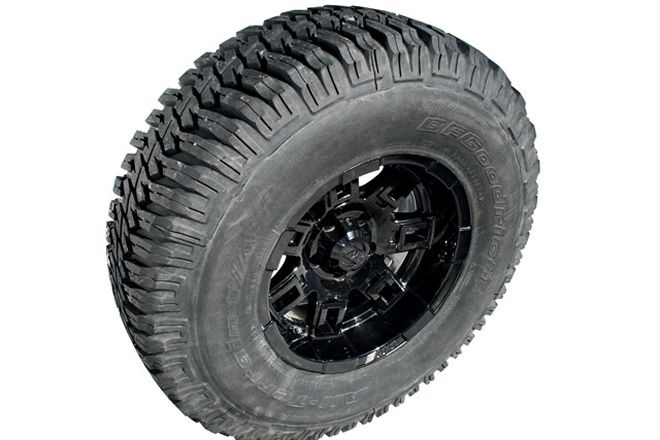
Do recaps have a place in the off-highway world? We wanted to find out, so we ordered two sets of remanufactured 31x10.50-15s from a well-established company called Treadwright.
Why two sets? The Treadwright Ultra-Grip 2 has the same tread design as the company's M/T but has crushed walnut shells imbedded into the rubber that break out, making numerous small biting edges to enhance snow and ice traction. Ours were on BFGoodrich KO casings that provided three-ply sidewall protection. All Treadwright tires are subjected to a vigorous inspection program prior to recapping. Treadwright offers many different sizes as well as tread patterns.
We mounted one set on some Mickey Thompson Classic 8-inch-wide aluminum wheels and the second set on the newly released Mickey Thompson black powdercoated aluminum "SideBiters." We spun each wheel on the balancer before mounting the tires, and they ran extremely true. When mounted, the Treadwrights took about four ounces per tire on average to balance.
A Jeep YJ that gets driven 90 miles a day on a high-speed interstate highway, plus weekends on backcountry logging roads to get to favorite hunting areas, was our primary test vehicle, along with our past project "Ain't It Grand-er" Grand Cherokee. Montana road conditions demand a versatile tread to adequately handle dirt, gravel, mud, pavement, snow, slush, ice, washboard, and potholes at any speed, and often all within a mile or two.
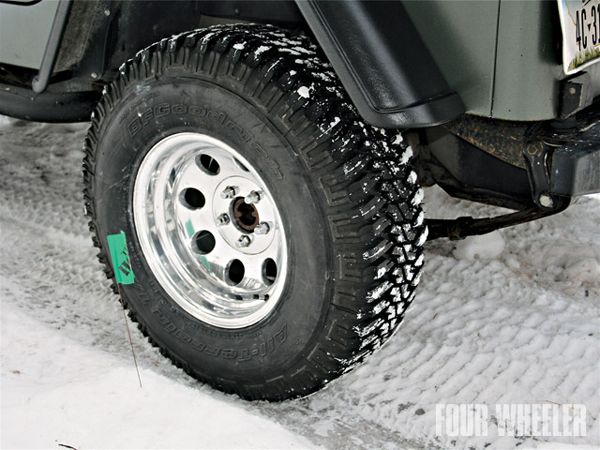 One phase of our tire testing was a slick ice hill climb. This set of Treadwrights was mounted on Mickey Thompson Classic wheels.
One phase of our tire testing was a slick ice hill climb. This set of Treadwrights was mounted on Mickey Thompson Classic wheels.
On the highway, the M/T tread design is very stable. The tires rolled straight and predictably, with no tendency to get pulled into the seams at the center and edge of the road or into cracks along the road. At low speeds, we could feel low-frequency vibrations from the tread that increased to a noticeable growl at highway speeds. The noise is louder on asphalt than concrete. The tread blocks are aligned more perpendicularly than diagonally across the tread with little overlap from one row of blocks to the next, which probably contributes to both the low-speed vibration and high-speed noise. Tread squirm is minimal at lowered air pressures, and the tires are very stable, both on packed dirt and loose gravel. Cornering at higher speeds than prudent on loose gravel was very stable, with smooth, controlled drifting and no tendency to suddenly break loose in the marbles.
In half a foot of cold, dry snow, the tires compress the snow and grip well because the perpendicular lines of the tread blocks act like paddles on a snowmobile track. This traction more than compensates for the noise of the design. In the snow, slush, and ice of winter storms on the highway, the tires felt stable. They provided some warning by feeling twitchy well before spinning when we were going too fast or hit some extra-slippery ice. At slower speeds, the tires could be made to slide or spin, but they would regain traction quickly when braking or acceleration was moderated. In general, the M/T is a good tread on snow, but average on ice.
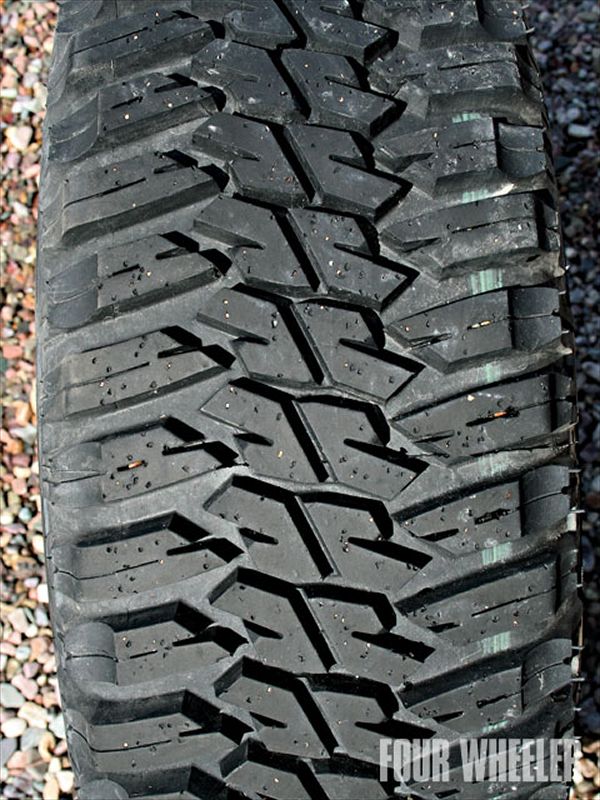 The only difference in the two different tires was that the Ultra Grip 2 has walnut shells embedded in the tread. These offer a definite advantage under icy conditions. As the walnut shells break out they leave small holes that also enhance traction.
The only difference in the two different tires was that the Ultra Grip 2 has walnut shells embedded in the tread. These offer a definite advantage under icy conditions. As the walnut shells break out they leave small holes that also enhance traction.
After nearly 6,000 miles, the tread depth indicated they should last at least 50,000 miles with the use we were giving the M/Ts.
We then switched to Treadwright's Ultra-Grip 2 tires and put a few thousand miles on them. Since the M/Ts and Ultra-Grip 2s are identical (other than the walnut shells in the Ultra-Grips), we ran a test to see if the walnut shells made any difference. We found a steep, icy driveway that was built to about a 12-percent grade. There was no challenge in four-wheel drive, so we idled from flat ground up the driveway in two-wheel drive numerous times to the point of slippage: first with the Ultra-Grip 2 tread tires, then with the M/T tread. The Ultra-Grip 2 with the walnut shells regularly got us about 62 feet up the drive before spinning to a stand-still. The M/Ts only averaged about 47 feet. We are sure that this corresponds not just to climbing traction but to stopping distance. That improvement in ice traction can save a life if you don't push the limits of the tread.
These inexpensive, remanufactured tires are welcome in our on- and off-road world. They work every bit as good as other popular brands for dirt and snow traction and highway stability
Winter is as tough on wheels as it is on tires. As we expected, the Mickey Thompson Classics got tarnished and pitted even though we made a considerable effort to keep the wheels clean of road salts. The SideBiters showed no signs of deterioration, and they are the only wheel we've ever used that actually looked better the dirtier it got. The dirt highlighted the aggressive angles in the design that were otherwise camouflaged by the excellent powdercoating.
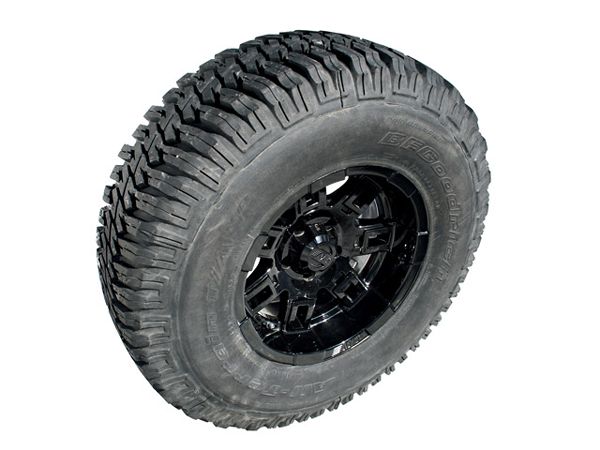 The aggressive black powdercoated Mickey Thompson SideBiter wheel and the aggressive Treadwright tire make for an impressive combination.
The aggressive black powdercoated Mickey Thompson SideBiter wheel and the aggressive Treadwright tire make for an impressive combination.
Specifications
Tire: Treadwright Ultra Grip 2 on BFG KO casings
Size: 31x10.50/15
Type: Radial
Max load rating (lb @ psi): 2,270 @ 50
Tread: 3-ply polyester, 2-ply steel
Sidewall: 3-ply polyester
Weight (lb): 42
Tread width (in): 7 3/4
Tread depth (in): 19/32
Static loaded radius (in): 30.24
Revolutions per mile: 667.3
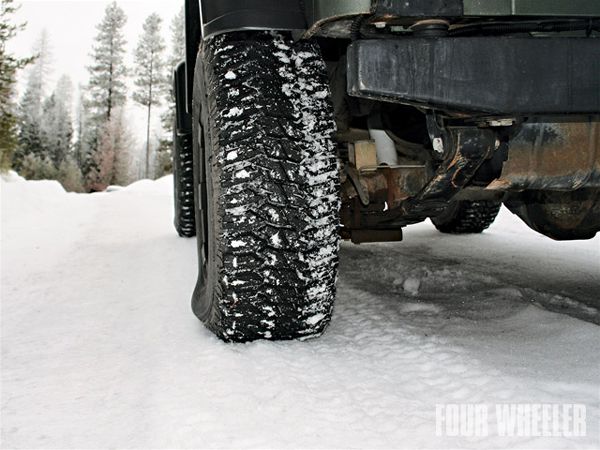 Lower air pressure makes for great flotation on snow, but higher pressure and a narrow tread makes for better traction on ice.
Lower air pressure makes for great flotation on snow, but higher pressure and a narrow tread makes for better traction on ice.
Tire Pressure In Ice And Snow
We get to do a lot of ice and snow driving in our Montana hide-out. Each year, "they" seem to keep adding days to the months of February and March. Pretty soon, I expect them to have 45 days each, and naturally they've got to get them someplace, so they will take them away from July and August. OK, did I make my point? We do a lot of ice and snow driving. It's pretty common knowledge that snow driving is a lot like driving in sand, in that you want to stay on top of the snow, especially deep snow. Sure, it's great to be able to dig down to solid ground, but once the snow is over about one third of your overall tire height, that front axle makes for a terrible snow plow. The lower the air pressure, the wider the footprint and the more flotation. Makes driving in deep snow so much easier. But what about roads that just have a few inches of snow on them or are icy? Does lower pressure work as a traction benefit or a hindrance?
During a recent tire test, we played around with air pressure on some 31x10.50-15s while trying to climb a hill-a very slick hill of smooth glare ice, ice rink-type ice. We started out with a normal street pressure of 31 pounds and made a high mark, then progressively lowered the air pressure in about 10 pound increments. Our next pass up the hill was only about two thirds the distance. Must have been a fluke, since more tire on the ground equals more traction, right? OK, try it again with the same results. Now we're down to about 10 psi and some great flexing tires. Didn't make it half the distance this time. Why? Again it had to do with ground pressure. The less the tire contacted the road's surface, the more psi it exerts. This high ground-pressure footprint makes for better traction.
This can also relate to lightly snow-covered roads. The higher ground pressure that a narrow tire exerts allows the tire to dig down to a more solid footing for better traction. So when it's deep snow, lower the pressure and use the widest tire you can run, but on the ice, keep the pressure high and consider a bit narrower tire.
-Willie Worthy
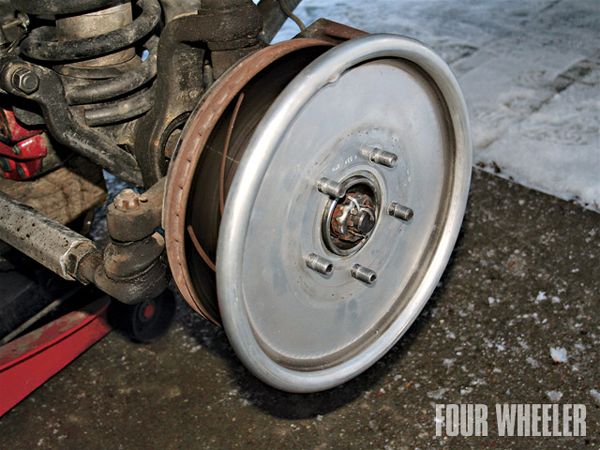 The Centramatic balancer consists of an aluminum ring, partially filled with a balancing media, that is mounted to a flat aluminum plate. The ring is offset to allow it to be closer to the center of the wheel and/or clear the brake rotor.
The Centramatic balancer consists of an aluminum ring, partially filled with a balancing media, that is mounted to a flat aluminum plate. The ring is offset to allow it to be closer to the center of the wheel and/or clear the brake rotor.
Tire Balancing With Centramatics
We are believers in balancing tires. Yes, it is a pain and expensive, especially when weights are subject to being knocked off by trail obstacles. But balancing has more benefits than just a smoother ride. An unbalanced tire will actually skip when going down the road, causing an uneven wear pattern, which in turn leads to fewer miles out of the tires. The vibrations that an out-of-balance tire sets up are transmitted to the wheel bearings and steering components, which in turn shortens their life. Some styles of aluminum wheels just don't take clip-on weights very well (or even not at all), and the weights sure don't enhance the appearance of the wheel for those concerned with such things. We've also found that some belt shifting takes place over the life of the tire, so what is "in balance" when new will most likely be "out of balance" at a later time.
We have been looking at the ads for Centramatic wheel balancers for quite some time now and really wondering if they did work as claimed. For those not familiar with them, these are flat discs with an outer ring that contains some type of magical balancing material in them. The discs mount between the brake rotor or drum and the wheel. Actually, there is no magic involved. The ring contains a material called Durametal that is a hardened lead alloy along with a synthetic oil to cut down on friction, which allows the material to move to a point, when rotating, opposite of the heavy spot on the tire/rim. The material starts moving and places the tire in balance from about 20 mph and up. They come four to a set and are around $200. Kind of pricey when you first look at it, but the last time we had some tires balanced, the price was $56 for four tires. Being that the Centramatics basically will last forever, and come with a 5-year warranty, it doesn't take much math to figure out how quickly they will pay for themselves.
Did they work as advertised? Well, yes, and kind of, and most likely would have even better if we had used a wheel with greater backspacing. We used them on a set of aluminum wheels which ran true and in close to perfect balance without the tires. They had 3 1/2 inches of backspacing in order to clear the steering knuckles that we were using. A wheel with more backspacing, such as most late-model vehicles use (like 4 1/2 to 5 inches) would have placed the balance ring closer to the center, or actually a bit over center, for a better average weight distribution. The balance going down the interstate was close but not perfect. Swapping the tires front to rear made an improvement, and we finally narrowed it down to one tire that had an above-average balance need of 5 ounces. So it seems the 15-inch version of the Centramatics are good up to about 4 ounces on a rim with the previously mentioned 3 1/2 inches of backspacing. Our guess is that on a larger-diameter rim, or one with more back spacing, the Centramatics can do a much better job.
We're going to keep running them even after we had the tires balanced in a normal manner, as they make for a great fine tuning tool as the balance of the tire changes with use. In fact, we liked them enough that we're going to order up another set and try them on a different tire/wheel combination Oh, one strange thing we did notice: while at our favorite fast food drive-through, we heard this strange noise that took us a minute to figure out. Seems that at slow speeds, as the balance media moves around in the ring, it make a grinding sound that echoed off the building's walls. We never did hear it on the trail.
-Willie Worthy
Source
Centramatic Balancers
800-523 8473
www.centramatic.com